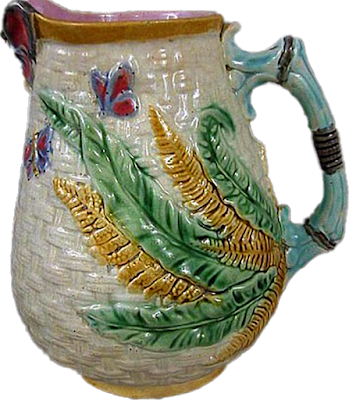It's been some time since we've had a post on majolica reproductions. They are consistently the most popular posts that we do. Is it any wonder? The sea of majolica reproductions grows deeper every year. Why such reproductions continue to flood into the US baffles us. Since the collapse of the mid-range and low-end markets for majolica eight years ago these reproductions are often selling for more than the originals. Perhaps it is because the cost of the reproductions is so low that it improves the margins of those dealer who try to pass them off as old. Or maybe it just comes down to ignorance. It is our belief that most general antiques dealers can't tell the difference between the reproductions and the antiques. That is the only rationalization we can offer for their presence in the inventory of reputable dealers. If you are a novice in buying majolica you are better off with a dealer who has a proven knowledge of the pottery.
One thing that these reproductions have in common is their poor quality. Most have unglazed sections in areas that are not commonly seen when on display, i.e. the interiors and the undersides. The areas that are glazed are usually terribly done with no definition and glaze dripping all over. Most are copies of existing antiques but recently there has been a flourish of new designs with no antique precedent. We will be showing both of these in this column in addition to some older reproductions that just don't want to die.
This first reproduction is of one of the most commonly found designs available–the majolica owl pitcher. With all of the originals available at reasonable prices why would anyone choose the reproduction with its muddy, runny glazes.
The next piece is brand new among reproductions. To the best of my knowledge it is an original design utilizing commonly seen decorative motifs. Note the particularly dull glaze, something you would never see in Victorian majolica
The heron comport below is a copy of a commonly found stand made by Forester with a pond lily plate top. This repro however seems to be from the same factory as the two repros above and appears to have been decorated by a child. The glaze is so badly done compared to the original that its appeal completely escapes me. Reproduction above, original below.
One thing that these reproductions have in common is their poor quality. Most have unglazed sections in areas that are not commonly seen when on display, i.e. the interiors and the undersides. The areas that are glazed are usually terribly done with no definition and glaze dripping all over. Most are copies of existing antiques but recently there has been a flourish of new designs with no antique precedent. We will be showing both of these in this column in addition to some older reproductions that just don't want to die.
This first reproduction is of one of the most commonly found designs available–the majolica owl pitcher. With all of the originals available at reasonable prices why would anyone choose the reproduction with its muddy, runny glazes.
Reproduction cockatoo pitcher
Victorian Shorter & Boulton majolica cockatoo jug
The next piece is clearly from the same factory as the one above.
Forester majolica dessert stand
Modern toby jug
The next repro is a take on the Minton acorn and snail jug. The interior and base are unglazed. The craftsmanship is clearly not that of the Minton factory.
Modern Minton reproduction jug
Reproduction blackberry plate
Victorian Arsenal Pottery majolica blackberry plate
This next reproduction is a copy of the Fielding butterfly lip pitcher. The give away that this is a reproduction are the poor quality of the workmanship and the opaque green glaze on the side which you would never see on a genuine Fielding piece.
Modern reproduction of a Fielding design
The next copy has been around for a while but in spite of its exceptionally poor quality and unglazed interior and base it is consistently being sold as genuine majolica which it is not. The original was made by Skey.
Reproduction Skey honey bear pitcher
The next reproduction is of the type of begonia leaf trays made by many different companies but made popular by the Etruscan Works of Phoenixville. The glaze however is very much NOT Etruscan. Something similar in nature is made by Leyden Arts Majolica of California, but those are clearly marked on the reverse. This is not.
Reproduction begonia leaf plate
The jug below is an exceptionally poor copy of a Sanford Pottery jug commemorating the Crimean War. The quality is so appallingly bad that it should be an easy one to pick out as a repro yet reputable dealers are still fooled.
Reproduction majolica jug




















No comments:
Post a Comment